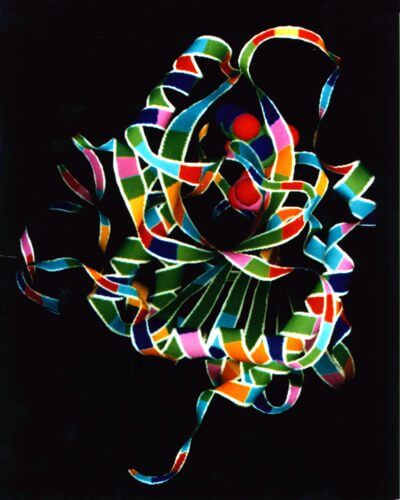Scientists and students from the Weizmann Institute of Science succeeded in a global experiment to predict the contacts between defined pairs of proteins that adhere to each other
 From right to left: Alex Hefetz, Boaz Shapira, Dr. Miri Eisenstein, Alex Barchansky and Efrat Ben-Zev. biological recognition
From right to left: Alex Hefetz, Boaz Shapira, Dr. Miri Eisenstein, Alex Barchansky and Efrat Ben-Zev. biological recognition
A group of scientists and students from the Weizmann Institute of Science succeeded in the global CAPRI experiment, when they presented good predictions regarding the three-dimensional spatial structures of three conjugates between pairs of known proteins. This year, 16 teams of scientists from the most important laboratories and research institutes in the world are participating in the CAPRI experiment ("Critical Assessment for Predicting Contacts between Proteins"). To date, they have been asked to predict in advance the shape of the structure of the three couplings formed when the three pairs of proteins stick together. Other research teams, working independently, studied at the same time - and explained - the real structures created by those protein pairs when they stick together. With the discovery of the real structures, the predictions of all the participants in the competition were compared to them, and it was found that only the group from the Weizmann Institute of Science submitted good predictions for all three couplings.

The team from the Weizmann Institute of Science included Dr. Miri Eisenstein from the Chemical Services Unit, and the research students Efrat Ben-Zev, Alex Barchansky, Alex Hefetz and Boaz Shapira from the Department of Biological Chemistry (another supervisor for the students' research work is Prof. Afraim Katzir from the Department of Biological Chemistry ). Dr. Eisenstein participated in another team of scientists from the Weizmann Institute, which won a similar competition six years ago. This team, headed by Prof. Katzir, also included Prof. Asher Prizm, and the research student at the time, Yitzhak Shariv, who is today the CEO of the "Yade" company.
The prediction of the three-dimensional spatial structure of conjugates between different proteins is a field of activity whose importance and scope are increasing in the era after the completion of the decoding and mapping project of the human genome. In this era, research is focused on the effort to decipher and understand the structure and function of the proteins, whose chemical sequence is encoded in the genes. Proteins are the main building blocks of the human body. Excess and lack of certain proteins, as well as poor or excessive function of other proteins, are the causes of a significant part of the known diseases and health disorders. Many drugs that are currently in use are nothing more than proteins, or fragments of proteins, that stick to the body's proteins, slowing down or inhibiting some of them, thereby increasing the activity of others. The development of a new drug is based in many cases on adjusting some protein to bind to another protein (for example, with the aim of preventing that protein from binding to another protein, thereby opening an unwanted process).
In this type of development process, the scientists try, more than once, to predict in advance the structure that two (or more) proteins will produce when they stick together. Such a prediction may greatly facilitate further research, especially when deciphering the true structure of the conjugate encounters difficulties. One of the techniques for making predictions of this type is based on the use of computer mathematical models of the known proteins. The computerized models are shown to each other at different angles and positions, with the aim of finding the most suitable position for adhesion between them (the compatibility is examined in terms of both the shape and the chemical properties). This operation is performed using an algorithm, a computerized recipe specially built to search and find the points where the proteins "anchor" each other in the process of sticking between them. The CAPRI experiment is, in fact, an ongoing competition between different algorithms built for the same purpose.
Predicting the structure that two proteins will produce when they adhere is a difficult task, both due to the great complexity (geometrical and chemical) of these molecules, and due to the fact that while adhering the proteins change their known free structure. To deal with this difficulty, the Weizmann Institute of Science scientists used computer models that show the two molecules determined by the competition organizers as rigid bodies designed according to the free structure of these molecules, that is, as they are designed when they are not bound to any other molecule. Using a unique algorithm developed at the institute, the scientists presented the models
These tough computers are pitted against each other, in different configurations, while examining the points of contact between them. For each touch point they gave scores according to the quality of the overall fit. This score was based on the weighting of the geometric-spatial match rate, and to a lesser extent, the electrostatic match rate. During the research, the scientists changed and improved their algorithm in order to include in the prediction also the changes that take place in the structures of the free proteins when they approach each other in the process of sticking between them. These changes - based on calculations and estimates - must be carried out very carefully, since a mistake in this area could cause a wrong change in the structure of one of the attached proteins, which will inevitably lead the prediction of the structure of the attachment to a dead end.
The scientists of the Weizmann Institute of Science carried out this task with complete success: they were the only ones among the 16 research teams that participated in the international experiment that managed to present good predictions of the structures of the three conjugates.
The three predictions for the adhesion of protein pairs
